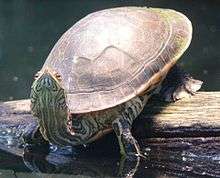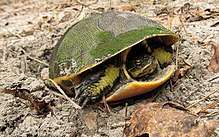Chicken turtle
The chicken turtle (Deirochelys reticularia) is an uncommon freshwater turtle found in the southeast of the United States. It is in the monotypic genus Deirochelys.
| Chicken turtle | |
|---|---|
 | |
| Chicken turtle lithograph of 1842 | |
 | |
| Chicken turtle basking | |
| Scientific classification | |
| Kingdom: | Animalia |
| Phylum: | Chordata |
| Class: | Reptilia |
| Order: | Testudines |
| Suborder: | Cryptodira |
| Superfamily: | Testudinoidea |
| Family: | Emydidae |
| Subfamily: | Deirochelyinae |
| Genus: | Deirochelys |
| Species: | D. reticularia |
| Binomial name | |
| Deirochelys reticularia (Latreille, 1801) | |
_Florida_Sub_adult.jpg)


The name "chicken" turtle refers to the taste of their meat, which used to be both common and popular in southern markets.[1]
Description
The chicken turtle is similar in appearance to the eastern painted turtle (Chrysemys picta picta), but has an unusually long, striped neck that is close to the length of its shell, with a yellow stripe on both the forelegs and rear legs. It has webbed feet to help it swim. It has a distinguishable net-like pattern on its carapace. The carapace is pear-shaped, and is an olive to dark brown. Females are usually larger than the males, and males have a bigger, longer tail. Males also have longer front claws. At birth, chicken turtles are one inch in diameter, and adults reach from 10.2-25.4 cm. The chicken turtle is medium in size compared to other turtles.
Behavior
Chicken turtles are regularly encountered on land, migrating between aquatic habitats or seeking areas to burrow into the soil and escape dry conditions. Males generally travel around farther than females. They are social, spending much of their time basking on logs and rocks and swim in small groups. Chicken turtles hibernate in the soft mud, but only in the northern part of their range, and vegetation of bodies of water. They are known to be timid but if caught they generally will bite very easily.
Lifespan
Wild chicken turtles have been recaptured up to 15 years after their first capture. Some reached the known maximum ages of 20 to 24 years.
Habitat
Chicken turtles are semiaquatic turtles, found both in water and on land. They prefer quiet, still bodies of water such as shallow ponds and lakes, ditches, marshes, cypress swamps, and Carolina bays. They prefer water with dense vegetation and soft substrate. Chicken turtles will also bask frequently and are tolerant of ephemeral aquatic habitats. They readily travel onto land to burrow into the soil and escape dry conditions.[1] They have been found at depths of a few centimeters to more than 2 m.
Reproduction
Males reproduce with female chicken turtles by vibrating the fore-claws against the female's face. Once the female is receptive, copulation occurs. Nesting season depends on latitude. For example, in Florida nesting takes place between mid-September and early March. Females lay between five and twelve eggs.[1] . A period of up to six months may pass between the mating event and the female laying her eggs.[2] Females excavate cylindrical nest on land in a variety of soil types, from sandy to heavy soils. Chicken turtle embryos go through a period of diapause in the late gastrula stage. They must experience a period of cool temperatures before development proceeds. Eggs hatch in 152 days at 29 Celsius, some eggs may overwinter in the nest before hatching. Incubation temperature influences the sex of the embryos, with a 25 degrees Celsius incubation temperature resulting in all males. Warmer temperatures result in an increase in female embryos, with only 11 percent becoming males at incubation temperatures of 30 degrees Celsius.
Diet
Chicken turtles are omnivorous, eating crayfish, fish, fruits, insects, invertebrates, frogs, tadpoles, and plants. During the first year of their lives, they are almost completely carnivorous. The chicken turtles strike out very fast with their long necks to catch live food[1]
Conservation status
Chicken turtle populations are currently considered stable throughout their range, although they do face potential threats. The eastern chicken turtle species is listed as state threatened in Virginia.[3] Habitat destruction reduces suitable habitat for foraging, migration, and hibernation. Chicken turtles are sometimes killed on roads as they migrate between habitats. Hunting for food impacts populations of chicken turtles as well. Racoons and alligators prey on juvenile chicken turtles.[1]
Subspecies
There are three distinct sub-species of chicken turtle:
- Eastern chicken turtle (Deirochelys reticularia reticularia)
- Florida chicken turtle (Deirochelys reticularia chrysea)
- Western chicken turtle (Deirochelys reticularia miaria)
References
| Wikimedia Commons has media related to Deirochelys reticularia. |
- Bonin, F., Devaux, B., Dupré, A., & Pritchard, P. C. H. (2006). Turtles of the World (1st ed.). Johns Hopkins University Press.
- Gibbons, W., Greene, J., & Hagen, C. (2009b). Turtles: The Animal Answer Guide (The Animal Answer Guides: Q&A for the Curious Naturalist) (0 ed.). Johns Hopkins University Press.
- "Archived copy" (PDF). Archived from the original (PDF) on 2010-11-04. Retrieved 2010-12-03.CS1 maint: archived copy as title (link)
